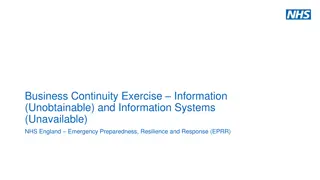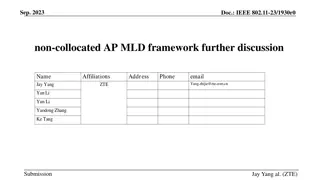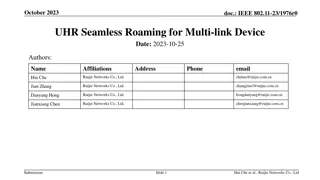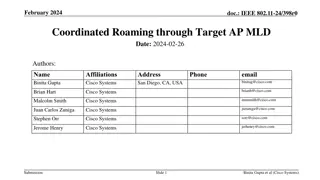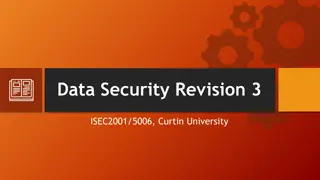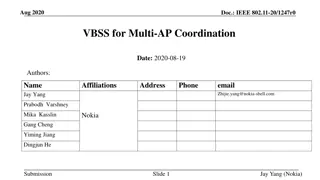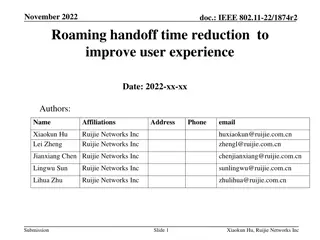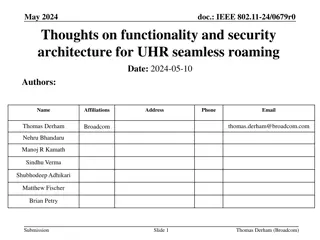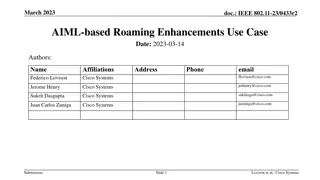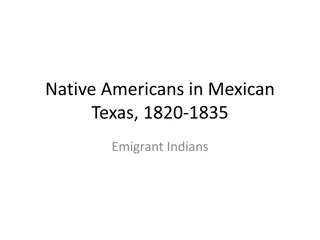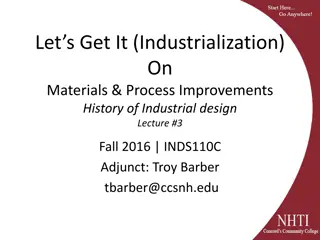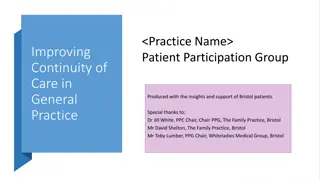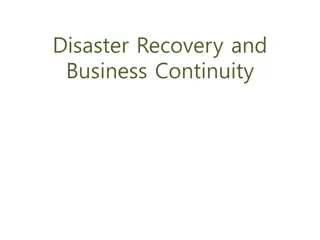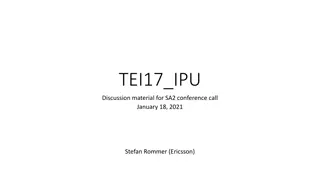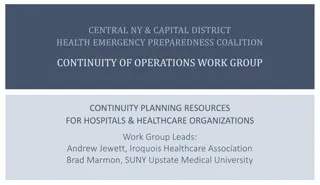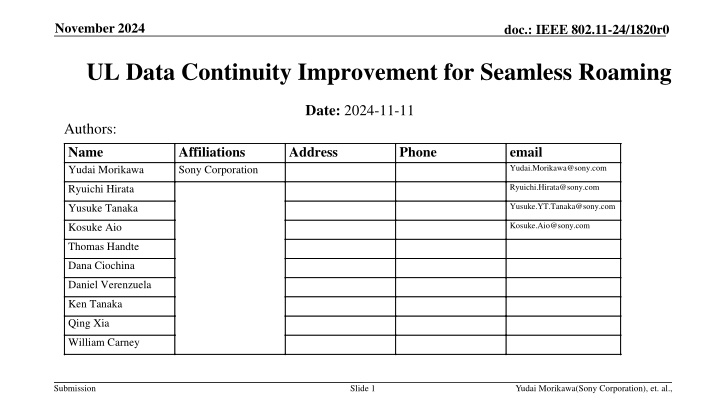
Improving UL Data Continuity for Seamless Roaming in IEEE 802.11-24
Explore the proposal to enhance UL data continuity during seamless roaming in IEEE 802.11-24 networks. Addressing the impact of UL suspension on low latency and mission-critical applications, the document discusses protocols and solutions to maintain data continuity, ensuring reliability and efficiency during roaming procedures.
Uploaded on | 0 Views
Download Presentation

Please find below an Image/Link to download the presentation.
The content on the website is provided AS IS for your information and personal use only. It may not be sold, licensed, or shared on other websites without obtaining consent from the author. If you encounter any issues during the download, it is possible that the publisher has removed the file from their server.
You are allowed to download the files provided on this website for personal or commercial use, subject to the condition that they are used lawfully. All files are the property of their respective owners.
The content on the website is provided AS IS for your information and personal use only. It may not be sold, licensed, or shared on other websites without obtaining consent from the author.
E N D
Presentation Transcript
November 2024 doc.: IEEE 802.11-24/1820r0 UL Data Continuity Improvement for Seamless Roaming Date: 2024-11-11 Authors: Name Yudai Morikawa Affiliations Sony Corporation Address Phone email Yudai.Morikawa@sony.com Ryuichi.Hirata@sony.com Ryuichi Hirata Yusuke.YT.Tanaka@sony.com Yusuke Tanaka Kosuke.Aio@sony.com Kosuke Aio Thomas Handte Dana Ciochina Daniel Verenzuela Ken Tanaka Qing Xia William Carney Submission Slide 1 Yudai Morikawa(Sony Corporation), et. al.,
November 2024 doc.: IEEE 802.11-24/1820r0 Introduction Seamless roaming has been discussed in TGbn and there has been agreements on some basic procedures in the SFD [1]. However, UL suspension occurs during roaming procedure between AP MLDs [2-3]. UL suspension may result in UL data discontinuity, and it causes a significant impact on interactive use cases and mission-critical use cases [4] that require low latency and high reliable UL transmission. UL suspension occurs during the roaming procedure regardless of architecture such as FT-based roaming [5] or SMD-based roaming [6]. This contribution proposes and discusses some protocols to solve the data discontinuity caused by UL suspension during the roaming procedure. Submission Slide 2 Yudai Morikawa(Sony Corporation), et. al.,
November 2024 doc.: IEEE 802.11-24/1820r0 Recap: Roaming procedure and UL suspension The roaming procedure is initiated by sending a request frame. Non-AP STA sends a roaming request frame (non-AP initiated roaming) [1]. AP may also send a roaming request frame (AP initiated roaming). The roaming procedure performs context transfer to the Target AP and performs necessary DS mapping change [1]. Once the roaming procedure is initiated, UL transmission to Current AP is suspended. Non-AP STA can send UL traffic to Target AP after reception of notification of the DS mapping change or reception of the roaming response frame. UL suspension Target AP Context transfer DS mapping change Roaming res. may Ack Current AP Non-AP STA may Ack Roaming req. Submission Slide 3 Yudai Morikawa(Sony Corporation), et. al.,
November 2024 doc.: IEEE 802.11-24/1820r0 Necessity of UL data continuity improvement In some use cases, low latency UL transmission is required. XR (e.g. See-through) use cases: UL pose/control information need to be delivered in certain period because DL video traffic is generated based on the UL traffic. Haptics use cases: Real-time and bidirectional communication are required. In case of Industrial IoT, it could be mission critical use cases [4]. Requirements [7-8] Haptics (Automotive) XR Reliability 99.999 (w/compr.) % 99 % Latency 1-10 ms 10 ms Buffered traffic Lifetime If non-AP STA is buffering low latency traffic for such use cases during roaming procedure, data continuity of the traffic can not be maintained due to UL suspension. UL suspension Target AP Current AP UL2 UL1 Lifetime Hence, we will address improvement of UL data continuity, minimizing the impact on roaming procedure. Non-AP STA Drop Roaming req. Roaming res. Submission Slide 4 Yudai Morikawa(Sony Corporation), et. al.,
November 2024 doc.: IEEE 802.11-24/1820r0 Proposals Buffered UL Proposal 1 Proposal 1: Non-AP STA sends an indication of initiating roaming procedure at desired timing. Pre-negotiation Current AP Roaming res. Lifetime Non-AP STA UL traffic with roaming procedure indication Proposal 2 Proposal 2: Non-AP STA sends low latency UL traffic before the roaming response frame. Pre-negotiation Current AP Non-AP STA Roaming req. Roaming res. Proposal 3: Non-AP STA sends its buffer status to enable low latency transmission after the roaming response frame. Proposal 3 Target AP Notify buffer status Non-AP STA Roaming req. Roaming res. with trigger Submission Slide 5 Yudai Morikawa(Sony Corporation), et. al.,
November 2024 doc.: IEEE 802.11-24/1820r0 Proposal 1 Problem Statement: If roaming procedure, during which UL transmission is suspended, is initiated while non-AP STA is buffering traffic, the lifetime of the traffic will expire due to UL suspension. In case of AP-initiated roaming, AP may send a roaming request frame to non-AP STA that is buffering low latency traffic. In case of STA-initiated roaming, non-AP STA may send a roaming request frame before low latency UL traffic if roaming request frame has higher priority or is queued earlier. Buffered UL Current AP Lifetime Non-AP STA Roaming req. and may Ack exchange Proposal 1 Statement: Non-AP STA sends an indication to initiate roaming procedure at desired timing. Non-AP STA includes the indication in UL traffic (MAC header)so that low latency traffic can be reliably sent before roaming request frame. In case non-AP STA cannot send low latency UL traffic by expiration, the roaming initiation time may be set. Proposal 1 Pre-negotiation Current AP Roaming res. Lifetime Non-AP STA UL traffic with roaming procedure indication Submission Slide 6 Yudai Morikawa(Sony Corporation), et. al.,
November 2024 doc.: IEEE 802.11-24/1820r0 Proposal 2 DS Current AP Problem Statement: Unexpected low latency UL traffic may be generated during roaming procedure, and the expiration time is before the roaming response frame. In that case, the traffic may have to be sent before the roaming response frame. Non-AP STA Roaming req. Roaming res. DS Target AP Proposal 2 Statement: Non-AP STA sends low latency UL traffic before the roaming response frame. Current AP Non-AP STA Roaming req. Roaming res. There are three cases of UL transmission. 1. UL traffic is sent to Current AP and then delivered to the DS 2. UL traffic is sent to Current AP, forwarded to Target AP and then delivered to the DS 3. UL traffic is sent to Target AP and then delivered to the DS DS Target AP Non-AP STA Roaming res. Roaming req. Submission Slide 7 Yudai Morikawa(Sony Corporation), et. al.,
November 2024 doc.: IEEE 802.11-24/1820r0 Details of Proposal 2 Concerns: In case non-AP STA sends UL traffic to Current AP before the roaming response frame, there are concerns about DS mapping change or context change. If DS mapping change is initiated, Current AP cannot deliver UL traffic to the DS. If Current AP delivers UL traffic to the DS, the context shared with Target AP changes. DS mapping timing Context change Disable to deliver DS Context transfer Target AP Current AP Non-AP STA Roaming req. Roaming res. Solutions: Current AP can deliver UL traffic to the DS during specified period. Current AP can only send permitted UL traffic during roaming procedure and verifies changed contexts with Target AP at (before) the roaming response frame exchange. UL data forwarding is also one of the solutions. Specified period DS Verify changed contexts Target AP Current AP Non-AP STA Roaming req. Roaming res. Submission Slide 8 Yudai Morikawa(Sony Corporation), et. al.,
November 2024 doc.: IEEE 802.11-24/1820r0 Buffered traffic Proposal 3 Fig. a may send buffer status and request low latency transmission Indication Problem Statement: Unexpected low latency UL traffic may be generated during roaming procedure, and the expiration time is after the roaming response frame. In that case, the traffic may not have enough lifetime left after roaming procedure. Target AP Current AP Non-AP STA Roaming res. Roaming req. Fig. b Proposal 3 Statement: Non-AP STA sends its buffer status to enable low latency transmission after the roaming response frame. Examples to enable low latency UL transmission: Current AP sends an indication that Non-AP STA has low latency traffic (Fig. a). Target AP triggers low latency UL traffic with the roaming response frame (Fig. b). may send buffer status and request low latency transmission Target AP Current AP Non-AP STA Roaming req. Roaming res. with trigger Submission Slide 9 Yudai Morikawa(Sony Corporation), et. al.,
November 2024 doc.: IEEE 802.11-24/1820r0 Summary UL suspension occurs during roaming procedure between AP MLDs. UL suspension may result in data discontinuity for low latency UL traffic, and it causes a significant impact on interactive and mission-critical use cases. Thus, we discussed how to improve UL data continuity, minimizing the impact on roaming procedure: Proposal 1: Non-AP STA sends an indication to initiate roaming procedure at desired timing. Proposal 2: Non-AP STA sends low latency UL traffic before the roaming response frame. Proposal 3: Non-AP STA sends its buffer status to enable low latency transmission after the roaming response frame. We can combine these three proposals. Source AP Target AP Before roaming procedure Proposal 1 Useless During roaming procedure Proposal 2 Proposal 2 After roaming procedure Useless Proposal 3 Submission Slide 10 Yudai Morikawa(Sony Corporation), et. al.,
November 2024 doc.: IEEE 802.11-24/1820r0 References [1] 24/171r15, TGbn Motion Lists, Alfred Asterjadhi (Qualcomm Inc.) [2] 24/0052r0, Seamless Roaming Details, Duncan Ho (Qualcomm Inc.) [3] 24/1086r0, Data forwarding for seamless roaming, Ryuichi Hirata (Sony) [4] 24/1493r1, Use Cases for Wi-Fi Business Solutions in UHR, Akira Kishida (NTT) [5] 24/0349r3, Enhance Fast BSS Transition, Guogang Huang (Huawei) [6] 24/0396r2, Seamless Roaming within a Mobility Domain Follow Up, Binita Gupta (Cisco Systems) [7] O. Holland et al., "The IEEE 1918.1 Tactile Internet Standards Working Group and its Standards," in Proceedings of the IEEE, vol. 107, no. 2, pp. 256-279, Feb. 2019. [8] Study on XR (Extended Reality) evaluations for NR, 3GPP TR 38.838 v 17.0.0, Dec. 2021. Submission Slide 11 Yudai Morikawa(Sony Corporation), et. al.,
November 2024 doc.: IEEE 802.11-24/1820r0 Appendix 1: Effective case of Proposal 1 Although non-AP STA has no buffered low latency UL traffic when roaming procedure is initiated, there is a possibility that the initiation timing of roaming procedure is not optimal. Next low latency UL traffic may be buffered immediately after roaming procedure is initiated If Non-AP STA knows the timing of next UL traffic generation, Non-AP STA may adjust the initiation timing of roaming procedure by Proposal 1. Traffic periodicity Traffic periodicity Current AP Buffered traffic Roaming res. Lifetime Non-AP STA Buffered roaming req. Roaming req. Other Non-AP STA Submission Slide 12 Yudai Morikawa(Sony Corporation), et. al.,
November 2024 doc.: IEEE 802.11-24/1820r0 Appendix 2: Effective case of Proposal 2 (Case 1) In case R-TWT is adopted between Non-AP STA and Current AP, next UL traffic transmission from Non-AP STA can be expected. In that case, DS mapping change is initiated after R-TWT SP to deliver UL traffic to the DS. R-TWT SP DS DS mapping Current AP Non-AP STA Roaming req. Roaming res. Submission Slide 13 Yudai Morikawa(Sony Corporation), et. al.,
November 2024 doc.: IEEE 802.11-24/1820r0 Appendix 3: Supplement to Proposal 2 (Case 3) In case non-AP STA sends UL traffic Target AP, and then Target AP delivers UL traffic to the DS, UL traffic is delivered to the DS after both DS mapping change and context transfer are performed. Non-AP STA can send UL traffic to Target AP during roaming procedure, but Target AP cannot deliver it to the DS until context transfer and DS mapping change has been completed. Non-AP STA can send UL traffic to Target AP, but Target AP cannot delivery it to the DS DS Deliver UL traffic after context transfer and DS mapping Context transfer and DS mapping Target AP Lifetime Non-AP STA Buffered traffic Roaming req. Roaming res. Submission Slide 14 Yudai Morikawa(Sony Corporation), et. al.,
November 2024 doc.: IEEE 802.11-24/1820r0 Appendix 4: Supplement to Proposal 3 In case of roaming procedure with single link [2], Current AP has to notify no buffer indication to send roaming response from Target AP. In case of roaming procedure with single link, link with Target AP is enabled after Current AP flushes remaining queued packets. Non-AP STA s buffer status information can be sent from Current AP when Current AP notifies no buffer indication. Current AP flushes remaining queued packets. Target AP Context transfer and DS mapping Notify no buffer indication and non-AP s buffer status Current AP Lifetime Non-AP STA Buffered traffic Roaming req. Roaming res. Submission Slide 15 Yudai Morikawa(Sony Corporation), et. al.,
November 2024 doc.: IEEE 802.11-24/1820r0 Appendix 5: Combination of three Proposals Although we discuss three solutions, we can combine three proposals to improve data continuity for UL traffic. e.g. UL periodicity is 4 ms. The expiration of UL traffic is 5 ms. Duration from roaming request to roaming response is 10 ms. Lifetime Buffered traffic DS Duration from roaming req. to roaming res. = 10 ms Target AP Pre-negotiation DS mapping change Current AP 5 ms Non-AP STA UL transmission to Current AP Proposal 2 UL traffic with roaming indication (Proposal 1) Roaming res. with trigger (Proposal 3) Submission Slide 16 Yudai Morikawa(Sony Corporation), et. al.,
November 2024 doc.: IEEE 802.11-24/1820r0 Appendix 6: Motions of Seamless Roaming Motion 2 11bn defines a mechanism that enables a non-AP MLD to roam from one AP MLD to another AP MLD and the non-AP MLD remains in state 4 (see 11.3) during and after roaming to the other AP MLD Motion 8 11bn defines a mechanism that when a non-AP MLD roams from one AP MLD to another AP MLD, the context related to the non-AP MLD is transferred from the one AP MLD to the other AP MLD such that it preserves the data exchange context for the non-AP MLD. Details of the context (e.g., security association context) that can be transferred are TBD Framework to transfer the context is TBD. Motion 26 Define in 11bn that when a non-AP MLD is in the process of roaming from the current AP MLD to a target AP MLD, the context related to the non-AP MLD is transferred to the target AP MLD such that it preserves the data exchange context for the non-AP MLD or the context can be renegotiated with the target AP MLD Details on what context can be transferred and what context can be renegotiated are TBD How to transfer the context is TBD. Submission Slide 17 Yudai Morikawa(Sony Corporation), et. al.,
November 2024 doc.: IEEE 802.11-24/1820r0 Appendix 7: Motions of Seamless Roaming Motion 27 As part of the seamless roaming procedure, during roaming, after the request/response exchange that initiates notification of the DS mapping change from the current AP MLD to the target AP MLD, The current AP MLD may deliver buffered DL data frames for a TBD period of time. The non-AP MLD may retrieve buffered DL data frames from the current AP MLD The non-AP MLD may send UL data to target AP MLD. It is assumed that the target AP MLD is able to deliver data frames to non-AP MLD after the DS mapping change The current AP MLD may forward DL data to the target AP MLD. When and how to initiate the forwarding of DL data is TBD Motion 28 Define in 11bn that a non-AP MLD can gather information on candidate AP MLD(s) over the DS via the current AP MLD Motion 44 Define a request frame sent by a non-AP MLD in state 4 to initiate the roaming procedure The roaming procedure performs context transfer to the target AP MLD and perform the necessary changes of the DS mapping from the current AP MLD to the target AP MLD Define a response frame sent to the non-AP MLD to indicate readiness for the non-AP MLD to send class 3 frames to the target AP MLD TBD on data transmission from non-AP MLD to current AP MLD during the request/response frame exchange NOTE What context is transferred is TBD. NOTE TBD on which request/response frame to use Slide 18 Submission Yudai Morikawa(Sony Corporation), et. al.,

